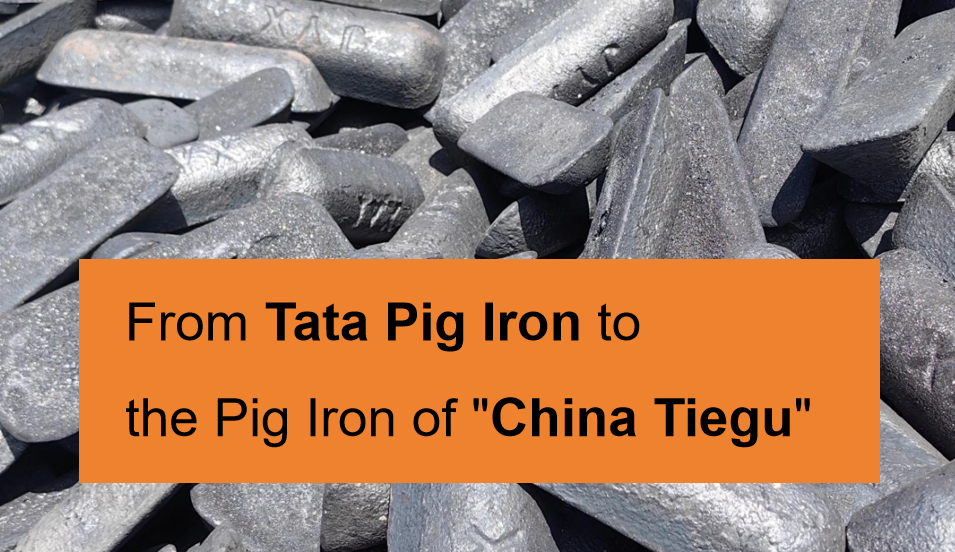From Tata Pig Iron to the Pig Iron of "China Tiegu"
2025-08-19 11:10:02 hits:0
From Tata to Tiegu: When Indian Resource Giants Encounter China's Pig Iron Efficiency Revolution
Subtitle: The New Competition - Cooperation Ecosystem of the Global High - end Casting Pig Iron Supply Chain
When Tata Steel dropped the bombshell news of a $1.18 billion expansion of its iron ore mines, the global steel industry was anticipating an explosive growth in India's pig iron production capacity. Meanwhile, at the intelligent terminal of Rizhao Port in China, high - end pig iron marked with the "TIEGU" logo was directly reaching foundries in Japan and South Korea within 72 hours through the unmanned inspection channel. This head - on confrontation between resource accumulation and efficiency innovation is reshaping the rules of the global high - end casting pig iron supply chain.

I. The Game between Resource Barriers and Efficiency Breakthrough: The Contest of Two Growth Logics
(1) Tata's In - depth Resource Layout
(2) China's Path of Efficiency Revolution
II. Quality Confrontation: A Comprehensive Comparison from Component Precision to Service Response
| Core Indicators | Tata's High - end Pig Iron | China's TIEGU High - end Pig Iron | Analysis of Technological Gap |
|---|---|---|---|
| Control of Key Elements | Phosphorus ≤ 0.07% (JIS G 2202 standard) | Phosphorus ≤ 0.03% (GB/T 718 AA grade) | China uses RH vacuum dynamic desulfurization, increasing the reaction efficiency by 40% |
| Customized Service Cycle | 14 days (standard grade) | 72 hours (23 customized solutions) | Flexible production lines + port pre - warehouses achieve a closed - loop of "order - production - shipment" |
| Green Certification System | European green steel label | ISO 14067 + FDA food contact certification | Built - in pre - inspection module for food - grade migrants, increasing the detection efficiency by 80% |
| Stability Fluctuation Range | Sulfur content ± 0.02% | Sulfur content ± 0.003% | Real - time regulation is achieved based on the big - data - based component prediction model |
(1) Benchmark Case
After the German Bosch Group, a global top - tier automotive turbocharger manufacturer, introduced TIEGU customized pig iron, the crack rate of thin - wall turbocharger housing castings caused by component segregation decreased from 3.2% to 0.1%, the yield rate increased by 11 percentage points, and the annual rework cost savings exceeded 2 million euros. Component precision has become the "life - and - death line" for high - end casting.
III. Scenario Positioning: The Competition - Cooperation Map of Three High - value Markets
| Application Scenarios | Tata's Advantageous Areas | TIEGU's Breakthrough Directions | Data Support for Core Competitiveness |
|---|---|---|---|
| Large - scale Infrastructure Castings | Cost - sensitive projects (accounting for 42% of revenue) | High - timeliness regional markets (such as Southeast Asian infrastructure) | Relying on the 8% lower local ore price, Tata won the bid for the Delhi Metro project in India |
| Precision Machinery Castings | Stable supply of traditional grades | Precise multi - element regulation (real - time adjustment of Mn/S ratio) | China's database covers over 1200 working conditions, increasing the solution response speed by 300% |
| Food - contact Utensil Castings | Require additional FDA certification | Built - in compliance module (100% pass rate) | Products of Yunnan enterprises have passed 26 food - contact tests in Japan and South Korea |
(1) Market Perspective
In 2024, China's export value of high - end casting pig iron increased by 27% year - on - year, with customized products accounting for 67% (data from the General Administration of Customs). Its share in high - end fields such as automotive precision castings and medical devices has reached 31%, confirming the market penetration of the "small - batch, fast - response" model.
IV. Ecosystem Symbiosis: The Global Collaborative Path of Resources and Technologies
(1) Tata's Digital Transformation Process
Its three "lighthouse factories" have achieved full - link visualization of orders, production, and logistics through the Aashiyana platform, compressing the delivery cycle from 7 days to 72 hours. However, the technical adaptability of the local supply chain in India limits its globalization replication speed.
(2) China's Construction of a Technology - export Ecosystem
The hydrogen - based pig iron project jointly developed by Shandong Steel and Indonesia has completed the feasibility study and is planned to be put into operation in 2026. By combining Tata's expertise in tropical iron ore pre - treatment technology with China's hydrogen reduction process, the goal is to reduce carbon emissions per ton of iron to 0.8 tons.
(3) Breakthrough in Collaboration
When Tata's technology of replacing dolomite with olivine (reducing the coke ratio by 21kg/thm) is combined with China's SRV® shaft furnace hydrogen circulation system, a composite process of "low coke consumption + high hydrogen ratio" can be formed, which is expected to further reduce carbon emissions by 12%, providing a "hybrid solution" for the zero - carbon transformation of the global steel industry. This complementarity between resources and technologies may reshape the global pig iron competition rules in the next decade.

 en
en  fra
fra  de
de  ru
ru  ara
ara  gle
gle  it
it  jp
jp  kor
kor  th
th  zh
zh 



